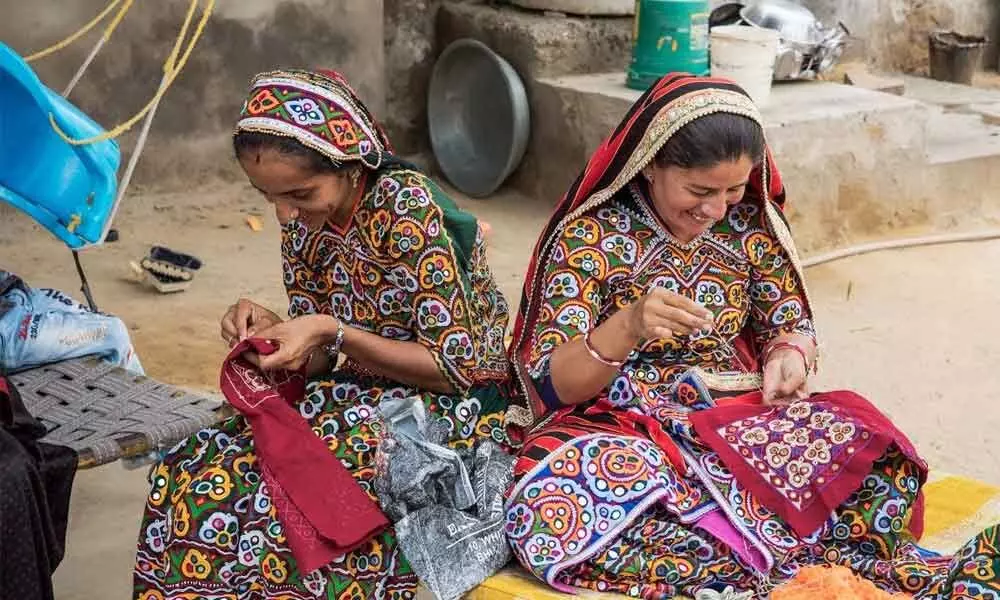Live
- Cabinet meeting in Assembly today
- Over 7,600 Syrians return from Turkiye in five days after Assad's downfall: minister
- Delhi BJP leaders stay overnight in 1,194 slum clusters
- Keerthy Suresh and Anthony Thattil Tie the Knot in a Christian Ceremony
- AAP, BJP making false promises to slum dwellers for votes: Delhi Congress
- 'Vere Level Office' Review: A Refreshing Take on Corporate Life with Humor and Heart
- Libya's oil company declares force majeure at key refinery following clashes
- Illegal Rohingyas: BJP seeks Assembly session to implement NRC in Delhi
- Philippines orders full evacuation amid possible volcanic re-eruption
- Government Prioritizes Welfare of the Poor, says Dola Sri Bala Veeranjaneyaswamy
Just In

The folk art from Gujarat
Almost everyone who loves Indian ethnic wear would either be the owner of a Kutch embroidery product or definitely have heard of it.
Almost everyone who loves Indian ethnic wear would either be the owner of a Kutch embroidery product or definitely have heard of it. This folk art from Gujarat is one of the bestsellers in the handicrafts and handlooms sector of the state. It is widely popular among women for attire and also in homes, offices and the hosptiality sector as it now comes in wall-hangings, table-runners, letter-holders, bedspreads, bags, waistcoats, jackets, scarves, stoles, etc.
The countless ways in which these products are embellished leaves you awed and amazed. The art is characterised by bright colours; intricate embroidery; use of mirrors. beads and sequins; the employing o fasilk/metallic, woollen and cotton fabrics/threads; and plenty of geometrical patterns. You will find motifs of animals and birds, plain squares and rectangles, and different kinds of flowers. The aari stitch which is uded by the cobblers or what is called the wine stitch are said to have Mughal influences. The wave-like patterns or circular ones that the folk artists create over the fabrics enhance its beauty. Human figurines especially those in dancing poses holding their 'batons' or 'dandiya sticks' as the laymen call them are frequently seen in this art. In one variety, tiny triangles are fitted into remarkably symmetrical patterns, again, all by hand! The colours in which you find these products are usually black, green, ochre, indigo, red and white.
As all of the above products are done by hand, it reveals the rich creativity and artistic skills of the tribals and rural artists and leaves one in admiration for them. Visiting the interior villages of the Kutch region, and watching the simple rural women, bent over the fabric, creating patterns purely inspired by their rich imagination, we were deeply impressed. When we complimented a few of them, they simply smiled or blushed and said that: "We are doing this from a very young age as did our mothers and grandmothers. We did not learn it at school or college. It comes naturally to us after observing our elders as we were growing up. And if we made any mistake it was they who would correct us and encourage us. Now, it is the praise of visitors like you all from all over India and the world which further motivates us."
This art is called Kutch embroidery because it is made by the artisans of the Kutch district in Gujarat, though now workshops are being held in urban areas of the state to train more artists. This is intended to give them a good livelihood and also allow the rich artistic traditions of the state to stay alive and moreover, thrive.
The guides told us of herringbone stitch, cross stitch, Abhala embroiderey, Heer Bharat, buttonhole stitch and running stitch and other technical terms (on our different visits to the state) acting as interpreters for the rural artists. This is a centuries-old tradition. We also came to know that women used to do this work in their spare time after tending to their home and children. Regarding the origins of this art, we were told of the Rabaris, a nomadic tribe or the Kathi cattle breeders whose fine needlework talent was the forerunner of this art. Another origin-story says that shoemakers or mochis were trained in this art nearly three centuries ago by a Muslim wanderer in Sindh. One leaflet handed out to us said there were seven distinctive styles of Sindh-Kutch embroidery namely Paako, Mutava, Suf, Khaarek, Rabari, and Garasia Jat. Whatever the technicalities, anyone who has seen this art being created in Gujarat or simply used one of these products will be all admiration for the kaliedisopic colours, endlessly creative motifs and sheer beauty of Kutch embroidery.

© 2024 Hyderabad Media House Limited/The Hans India. All rights reserved. Powered by hocalwire.com







